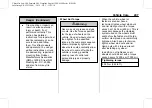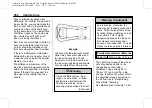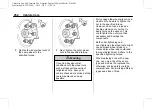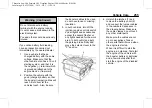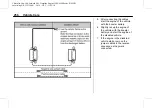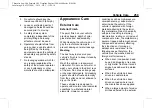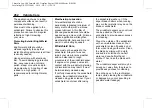
Chevrolet Low Cab Forward 6.0L Gasoline Engine 3500/4500 Series (GMNA-
Localizing-U.S.-12533400) - 2019 - CRC - 11/19/18
Vehicle Care
261
this precaution can lead to heat
deformation and breakage of plastic
components, or to water leaks into
the cab. When using an automatic
car or truck wash, ensure that a
distance of at least 0.4 m (15.75 in)
is maintained between the nozzle
and the vehicle, and when washing
door windows, that the spray is
perpendicular to the surface of the
glass.
Ensure that all detergent is fully
washed and wiped away.
Particularly in the case of strong
alkaline detergents (typically those
for industrial uses), there is a
danger that hairline cracks can
develop in lighting-cluster lenses if
the vehicle is operated without
detergent being fully wiped away.
Always read the detergent
manufacturer's instructions carefully
before use. Airborne dirt that
adheres to plastic front bumpers as
a result of rain, for example, can be
difficult to remove. In such a case,
use a commercially available
cleaner to clean away the dirt, and
then apply a wax for use with plastic
components.
Vehicle Storage
In order to maintain your vehicle's
attractive appearance as long as
possible, special consideration must
be given to its storage location.
If the vehicle is stored or kept for an
extended period of time in any of
the following locations, a chemical
change may occur in the paint work,
resulting in staining, discoloration,
rusting, and corrosion of
components.
.
Locations where a large amount
of oily matter, soot, heavy smoke
or metal powder can adhere to
the vehicle.
.
Areas around pharmaceutical
plants and other facilities that
discharge chemical matter.
.
Coastal areas
.
Locations where a large amount
of dead bugs, bird droppings or
tree sap can adhere to the
vehicle.
Polishing and Waxing
Periodic polishing and waxing is
recommended to remove built-up
residue and eliminate any
"weathered" appearance.
Your authorized dealer offers
several polishes and cleaners which
have proven value in maintaining
original finish appearance and
durability.
Painted and chrome-plated surfaces
should be waxed once or twice a
month, or whenever water is being
poorly repelled on the surfaces.
Ensure that wax is not applied in
direct sunlight, and that the
temperature of the painted surface
is no more than 40 °C (104 °F).
Always follow the instructions
provided with your wax product.
Do not use wax containing abrasive
material. Failure to observe this
precaution can lead to scratching of
painted surfaces or plastic
components.

